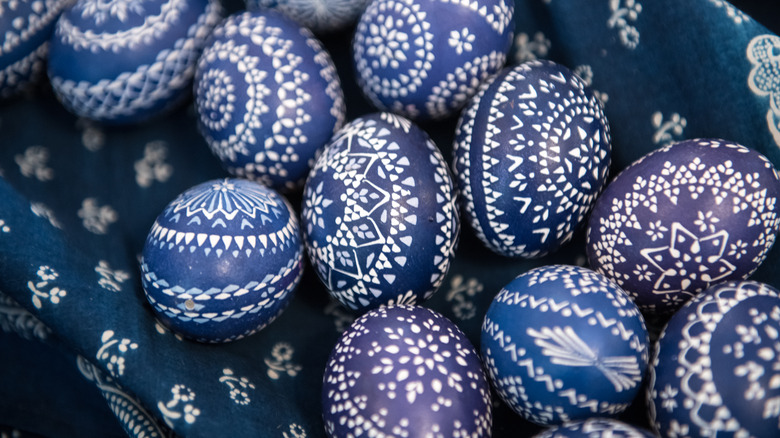What Is Polish Egg Salad And What Does It Taste Like?
No Easter breakfast in Poland is complete without pasta jajeczna. The name translates to English as "egg paste," but Americans will likely recognize it as the tried-and-true favorite, egg salad. In many ways, it's the perfect embodiment of Polish cuisine: hearty, comforting, and unpretentious. In keeping with these values, Polish food makes good use of staple food groups like meat, dairy, eggs, and starches. Pasta jajeczna is all about celebrating eggs.
Many types of egg salad are enjoyed around the world, but Poland keeps it simple. A typical recipe for pasta jajeczna uses only hard-boiled eggs, mayonnaise, fresh chives, and the obligatory salt and pepper. It's similar to classic American egg salad, so if you're familiar with that old picnic staple, you have a good idea of what the Polish version tastes like.
The one ingredient distinguishing pasta jajeczna from American egg salad is chive, which lends a bright note of garlicky-onion flavor. The other key difference is the hard-boiled eggs used in pasta jajeczna are diced much finer than those in American salad and are sometimes even grated, hence the name egg paste. Polish egg salad is easy to make at home and is served year-round in Poland. However, the best occasion for enjoying pasta jajeczna is undoubtedly Easter.
Eggs play a central role in Polish Easter customs
Eggs are a prominent symbol of Easter globally, but nowhere does this ring more true than in Poland. The predominantly Catholic nation celebrates the entire Holy Week, beginning on Palm Sunday and culminating with Śmigus Dyngus, aka Wet Monday, which seems like one of the coolest holidays ever conceived (it's literally an all-day water fight). Throughout the week, eggs are everywhere, serving decorative, ritualistic, and culinary purposes.
Poland is globally renowned for its hand-painted Easter eggs, known as pisanki. They also enjoy egg-shaped chocolates. These will likely be familiar customs to Americans, but Poland's Easter celebrations take eggs much further. For instance, traditional Polish Easter baskets contain a ritualistic selection of foods with symbolic meanings, including the representation of new life and the resurrection. Another Polish Easter game involves two competitors knocking hard-boiled eggs together, each trying to crack their opponent's egg before theirs is broken.
Most importantly, eggs are a core ingredient of Easter meals in Poland. The traditional holiday breakfast begins with the family peeling one of the boiled Easter eggs and dividing it into even wedges shared between all members. Other classic egg-based dishes include żurek, a rye soup with boiled eggs, eggs stuffed with meats and vegetables, and pasta jajeczna.
Pasta jajeczna isn't the only Polish egg salad
It's important to emphasize that the people of Poland don't refer to this dish as egg salad. Pasta jajeczna is egg paste, but when this recipe is served in the United States, it naturally gets likened to the American side dish to which it bears a resemblance. In Poland, references to egg salad could be interpreted as a completely different dish: sałatka jarzynowa.
Sałatka jarzynowa translates to English as "vegetable salad," but it's nothing like lettuce-based salads. Instead, sałatka jarzynowa centers around potatoes, eggs, and root vegetables such as carrots, celery root, and parsley root. It usually includes pickled cucumbers and peas as well. The ingredients are bound together by mayonnaise; the result is a bit like a cross between American egg salad and potato salad. Also, while pasta jajeczna anchors the Polish Easter breakfast, sałatka jarzynowa is the chosen egg salad of Christmas.
Both Polish egg salads are traditionally served as a holiday side dish to accompany different breads, meats, and cheeses. Pasta jajeczna is a bit more versatile, as its paste-like texture allows it to be used as a spread for pieces of bread and sandwiches. You can even use it to fill deviled eggs.


